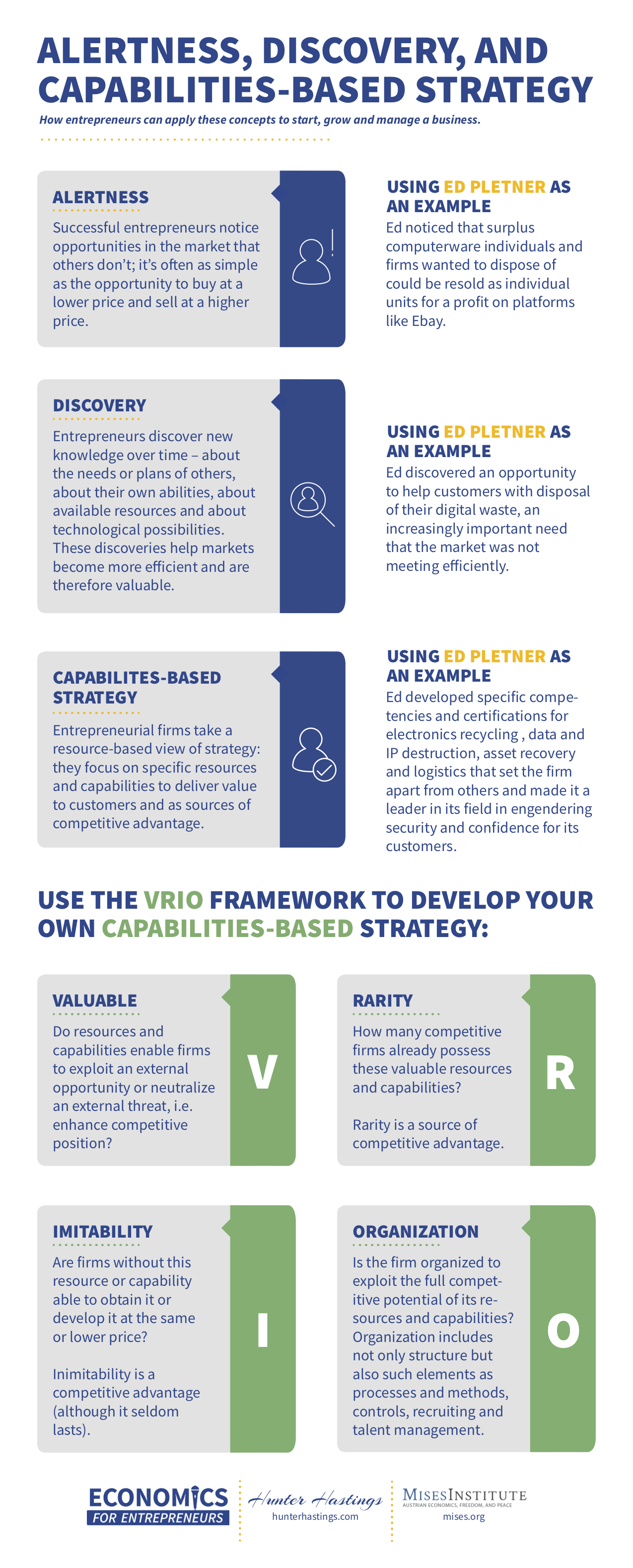11. Per Bylund – What Is Competition?
How should entrepreneurs think about the economic concept of competition? Is there anything to learn? Is thinking about the concept useful for entrepreneurs running businesses? We asked Per Bylund to steer us through this thicket.
Show Notes
In mainstream economic theory, competition occurs between producers or suppliers of commodities. The good is pre-defined and undifferentiated, and competition is a matter of price and the production function. If this theory were looking for an example, it might find it in the gasoline market, where there are lots of gas stations with identical product, everyone has the same information, and price is the main means of competition. Economic theory calls this “perfect competition”, which is an ideal compared to “imperfect competition” (monopoly, duopoly, oligopoly, etc). It’s all pretty unrealistic and there’s nothing for an entrepreneur to learn.
Austrian economics sees competition as entrepreneurs competing for the customer’s dollar. The starting point is consumer sovereignty – the idea that the consumer (or the customer in B2B exchanges) is the one to exercise choice, and therefore determine what is purchased and, consequently, which brands, products and services are successful. An entrepreneur is competing with all the other ways a consumer could spend their dollar: by not buying at all, by buying a direct substitute, or by spending it in another category, or by deferring their purchase to a later time.
To succeed in this competitive environment, the entrepreneur should seek to create unique value. The Austrian logic of competition is value-centric. Value is subjective – it’s a perception of the consumer or customer. The entrepreneur competes for the consumer’s dollar by creating a value that the consumer can not realize from any other source – including non-consumption. The entrepreneur searches for uniqueness, to find a niche where he or she can serve the consumer in a way that no-one else has done before. This is what Peter Thiel calls a “monopoly” in his book Zero To One: a unique offering in a precise niche.
The way to compete is to develop a better empathic understanding of consumers’ needs. Every entrepreneur has the opportunity to be the best at developing an understanding of a target customer’s needs. In many cases, the competitive edge will be in choosing the right audience to serve – narrow enough that the empathic diagnosis is specific and precise and therefore more likely to yield an opportunity to serve the segment in a unique way. Generalizations and common denominators may not be precise enough and may cause the entrepreneur to miss precisely what it is about an audience’s needs that provides an opening for differentiation. Differentiation means a higher level of perceived value for that audience.
Positioning and telling a uniquely persuasive story are a big part of competitive value delivery. In so-called “perfect competition”, all players, producer and consumers, have the same information. Of course, the opposite is true in real life. One of the important differences in information lies in how value is positioned to the consumer, how the value story is told. Entrepreneurs compete to tell the best stories and communicate in the most persuasive ways.
In this way of thinking about competition, so-called “business strategy” is not particularly useful. Five-year plans and specific organizational goals (like doubling sales) are not useful and there’s a high likelihood of failure. They represent the wrong focus. The right focus is “how can we increase value for the consumer” or “how can we be unique?” How can we satisfy consumers in ways that no-one else does? Dynamism means that all players are changing all the time, including consumers, and so entrepreneurs must be learning and adjusting all the time, and always trying to create new value.
Can strategy tools be useful? Strategy tools can be useful to help structure thinking and help you to be sure not to have overlooked some element you should have considered. The VRIO method helps you to think about assembling a unique set of resources to support a unique value delivery to customers. Modern entrepreneurship education offers a number of frameworks to help entrepreneurs in starting a business, like the Disciplined Entrepreneurship Canvas and the Lean Startup Canvas. They are both pretty good at starting with consumers and the value the entrepreneur can create for those consumers. We’ve re-created a few versions of the Lean Startup Canvas for you to download here:
- a version with explanatory notes, to help you better understand what each section represents and how it should be used (download);
- an annotated canvas that can be printed on regular letter-sized (8.5×11) printer paper (download);
- and a blank one that can also be printed, for you to complete yourself (download).
Bottom line: Austrian Economics’ value-dominant approach provides better guidance for entrepreneurs than the formulas for strategic thinking that come from business school. Start with the customer. Understand their needs, create value for them, and keep refreshing that value. In fact, this is a collaborative view of the market. Entrepreneurs share the desire to find a unique niche and establish a unique service, and they’re happy to compare notes and methods in order to help each other, which is one of our aims at Economics For Entrepreneurs.
